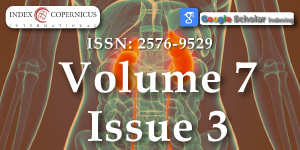Doppler Evaluation of Renal Vessels in Pediatric Patients with Relapse and Remission in Different Categories of Nephrotic Syndrome
Main Article Content
Abstract
Aim: To study resistivity & pulsatility indices in the interlobar arteries of kidneys in patients with idiopathic nephrotic syndrome and evaluate their response to steroids
Method: The prospective case-control study was carried out in 100 patients, aged 2 years - 15 years of nephrotic syndrome and divided into 5 groups depending upon their response to steroids. Twenty-five age-matched controls were included for comparison. The abdominal ultrasonography and Doppler examinations were performed for patients of each group and for the controls.
Result: The mean Resistivity Index (RI) and Pulsatility Index (PI) of the interlobar arteries were calculated for the five subgroups of nephrotic syndrome patients and for the controls. There was a significant difference in mean RI in all the evaluated arteries between the 6 groups. No significant difference was noted in the pulsatality indices of the kidney of the cases of nephrotic syndrome when compared to controls.
Conclusion: Steroid-resistant nephrotic syndrome patients show a statistically significant difference in RI and not a statistically significant difference in PI Doppler parameters when groups of patients compared to controls. These parameters may be used to predict the response to steroids.
Article Details
Copyright (c) 2023 Dhar Dwivedi AN, et al.

This work is licensed under a Creative Commons Attribution 4.0 International License.
Niaudet P, Gagnadoux MF, Broyer M. Treatment of childhood steroid-resistant idiopathic nephrotic syndrome. Adv Nephrol Necker Hosp. 1998;28:43-61. PMID: 9889985.
Hussain N, Zello JA, Vasilevska-Ristovska J, Banh TM, Patel VP, Patel P, Battiston CD, Hebert D, Licht CP, Piscione TD, Parekh RS. The rationale and design of Insight into Nephrotic Syndrome: Investigating Genes, Health and Therapeutics (INSIGHT): a prospective cohort study of childhood nephrotic syndrome. BMC Nephrol. 2013 Jan 26;14:25. doi: 10.1186/1471-2369-14-25. PMID: 23351121; PMCID: PMC3608224.
Chanchlani R, Parekh RS. Ethnic Differences in Childhood Nephrotic Syndrome. Front Pediatr. 2016 Apr 19;4:39. doi: 10.3389/fped.2016.00039. PMID: 27148508; PMCID: PMC4835686.
McKinney PA, Feltbower RG, Brocklebank JT, Fitzpatrick MM. Time trends and ethnic patterns of childhood nephrotic syndrome in Yorkshire, UK. Pediatr Nephrol. 2001 Dec;16(12):1040-4. doi: 10.1007/s004670100021. PMID: 11793096.
Bagga A, Srivastava RN. Nephrotic syndrome. In: Srivastava RN, Bagga A, editors. Pediatric Nephrology. 4th ed. New Delhi. Jaypee. 2005; 159-200.
Gershen RS, Brody AS, Duffy LC, Springate JE. Prognostic value of sonography in childhood nephrotic syndrome. Pediatr Nephrol. 1994 Feb;8(1):76-8. doi: 10.1007/BF00868271. PMID: 8142233.
Parolini C, Noce A, Staffolani E, Giarrizzo GF, Costanzi S, Splendiani G. Renal resistive index and long-term outcome in chronic nephropathies. Radiology. 2009 Sep;252(3):888-96. doi: 10.1148/radiol.2523080351. Epub 2009 Jun 15. PMID: 19528356.
Radermacher J, Chavan A, Schäffer J, Stoess B, Vitzthum A, Kliem V, Rademaker J, Bleck J, Gebel MJ, Galanski M, Brunkhorst R. Detection of significant renal artery stenosis with color Doppler sonography: combining extrarenal and intrarenal approaches to minimize technical failure. Clin Nephrol. 2000 May;53(5):333-43. PMID: 11305806.
Sugiura T, Wada A. Resistive index predicts renal prognosis in chronic kidney disease. Nephrol Dial Transplant. 2009 Sep;24(9):2780-5. doi: 10.1093/ndt/gfp121. Epub 2009 Mar 23. PMID: 19318356.
Atalabi OM, Afolabi OS, Asinobi AO. Renal Doppler Indices in Children with Nephrotic Syndrome: Findings from a Tertiary Hospital in Nigeria. Niger J Physiol Sci. 2015 Dec 20;30(1-2):17-23. PMID: 27506166.
Tsai CW, Kuo CC, Wu CF, Chien KL, Wu VC, Chen MF, Sung FC, Su TC. Associations of renal vascular resistance with albuminuria in adolescents and young adults. Nephrol Dial Transplant. 2011 Dec;26(12):3943-9. doi: 10.1093/ndt/gfr141. Epub 2011 Mar 28. PMID: 21444360.

